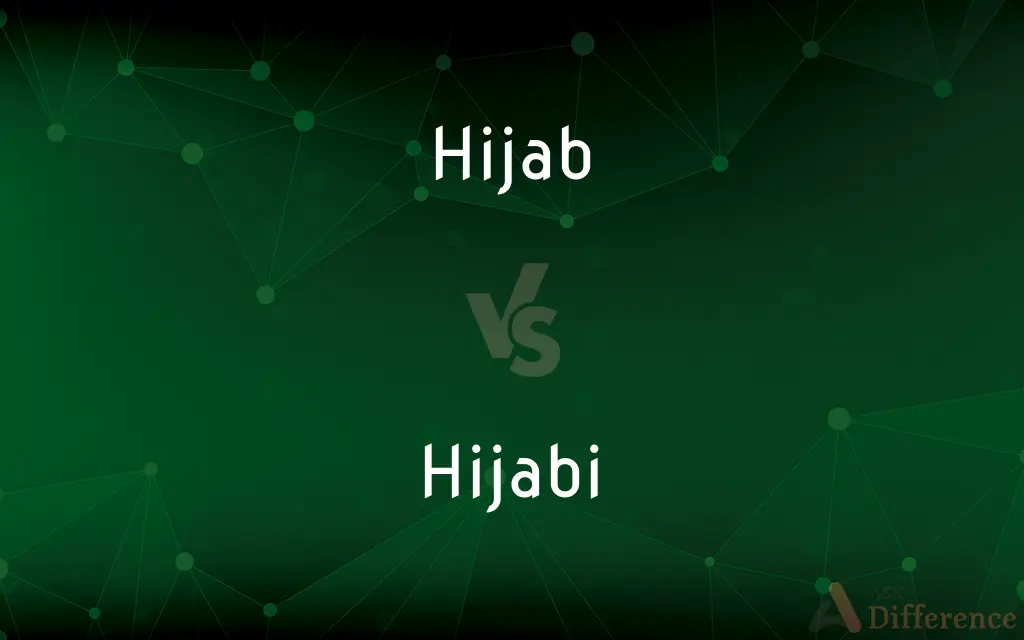Hijab vs. Hijabi — What's the Difference?
By Urooj Arif & Maham Liaqat — Updated on May 8, 2024
Hijab refers to the Islamic practice of modest dress, primarily a headscarf; Hijabi describes a woman who wears the hijab.

Difference Between Hijab and Hijabi
Table of Contents
ADVERTISEMENT
Key Differences
Hijab is a term used to describe both the act of covering and the actual cloth used by Muslim women for the purpose of modesty according to Islamic guidelines. Whereas, Hijabi is a descriptor used specifically for a woman who practices wearing the hijab. It is more of an identity label than a reference to the garment itself.
The concept of hijab extends beyond just the headscarf, encompassing a general philosophy of modesty that can include behavior and dress style. On the other hand, the term Hijabi focuses solely on the individual's choice and identity in relation to wearing the hijab, thus it is not used to describe the broader concept of modesty.
While hijab can be mandated by law in some countries, requiring women to adhere to specific dress codes in public, Hijabi is a personal identifier that a woman might choose to adopt even in countries where no such laws exist, signifying her personal commitment to this aspect of her faith.
The practice of wearing a hijab can vary significantly from one culture to another, influenced by local customs, traditions, and interpretations of Islamic law. On the other hand, being a Hijabi is a universal term applicable to all Muslim women who wear the hijab, regardless of the specific style or cultural variations.
In discussions about religious freedom and expression, hijab often comes up as a symbol of Muslim identity in secular debates. Conversely, Hijabi is used more within communities and personal narratives as a way to express individual stories and experiences related to wearing the hijab.
ADVERTISEMENT
Comparison Chart
Definition
Islamic practice of modest dress
Descriptor for a woman who wears a hijab
Usage Context
General and specific
Specifically personal
Legal Implications
Can be legally mandated
No legal implication, personal choice
Cultural Variation
Varies widely
Constant in meaning
Role in Discussions
Broader religious and cultural symbol
Personal identity and choice
Compare with Definitions
Hijab
Legally mandated in some countries.
In her country, wearing a hijab is required by law.
Hijabi
A Muslim woman who wears a hijab.
She is known in her community as a dedicated Hijabi.
Hijab
The practice of modesty in Islam.
Hijab involves more than just dressing modestly.
Hijabi
A term of identity within the Muslim community.
As a Hijabi, she feels a strong sense of belonging.
Hijab
A barrier or partition.
The curtain served as a hijab in the mosque.
Hijabi
Often used in personal narratives.
Her blog as a Hijabi discusses her experiences.
Hijab
A symbol of religious identity.
Her hijab proudly announces her faith.
Hijabi
Reflects a personal choice.
She became a Hijabi to express her personal faith.
Hijab
A headscarf worn by Muslim women.
She chooses a colorful hijab to wear every day.
Hijabi
Not related to legal requirements.
She is a Hijabi by choice, not by law.
Hijab
A hijab (; Arabic: حجاب, romanized: ḥijāb, pronounced [ħɪˈdʒaːb] in common English usage) is a religious veil worn by Muslim women in the presence of any male outside of their immediate family, which usually covers the hair, head and chest. The term can refer to any hair, head, face, or body covering worn by Muslim women that conforms to Islamic standards of modesty.
Hijabi
A person, usually a woman, who wears a hijab.
Hijab
Any of several cloth head coverings worn by Muslim women.
Hijabi
Alternative form of hijab.
Hijab
The veiling of women in some Islamic societies, customarily practiced in order to maintain standards of modesty.
Hijab
(countable) A traditional headscarf worn by Muslim women, covering the hair and neck.
Hijab
A headscarf worn by Muslim women; conceals the hair and neck and usually has a face veil that covers the face
Hijab
The custom in some Islamic societies of women dressing modestly outside the home;
She observes the hijab and does not wear tight clothing
Common Curiosities
Can men be called Hijabi?
No, the term Hijabi specifically refers to women.
Does wearing a hijab automatically make someone a Hijabi?
Yes, if a woman wears the hijab, she is considered a Hijabi.
Is hijab only about clothing?
No, hijab encompasses a broader concept of modesty in dress and behavior.
Can Hijabi women wear different styles of hijabs?
Yes, styles can vary widely depending on personal preference and cultural context.
Who is referred to as a Hijabi?
A Hijabi is a Muslim woman who chooses to wear the hijab.
Is the hijab worn for religious reasons only?
Primarily, yes, though cultural factors also play a role.
What does the hijab symbolize?
It can symbolize faith, identity, and a commitment to modesty.
How do non-Muslims generally perceive the hijab?
Perceptions can vary, often influenced by cultural, social, and political contexts.
What is a hijab?
A hijab is a head covering worn by some Muslim women as part of their practice of modesty according to Islamic tradition.
Is it possible to be a Hijabi at certain times and not at others?
Yes, some women choose to wear the hijab only at certain times or in certain settings.
Is there a difference in the hijab worn by older and younger women?
There can be, often influenced by generational attitudes and fashion trends.
How is Hijabi used in social contexts?
It's used to describe identity and community belonging among Muslim women.
Are all Muslim women required to wear a hijab?
The requirements can vary based on interpretations of Islamic teachings and cultural influences.
What challenges do Hijabis face?
They may face discrimination or stereotyping based on their visible expression of faith.
Does Hijabi imply a certain type of hijab?
No, Hijabi refers to the wearer, not the style of hijab.
Share Your Discovery

Previous Comparison
Alabaster vs. Quartz
Next Comparison
Amulet vs. MedallionAuthor Spotlight
Written by
Urooj ArifUrooj is a skilled content writer at Ask Difference, known for her exceptional ability to simplify complex topics into engaging and informative content. With a passion for research and a flair for clear, concise writing, she consistently delivers articles that resonate with our diverse audience.
Co-written by
Maham Liaqat















































